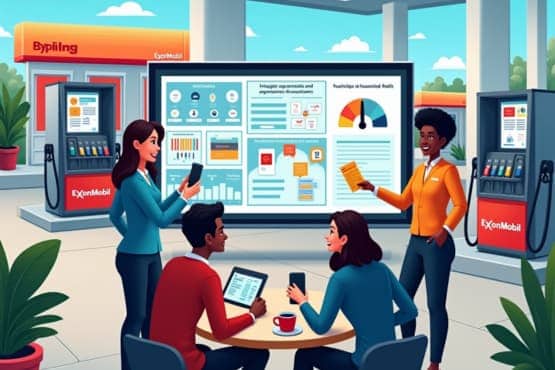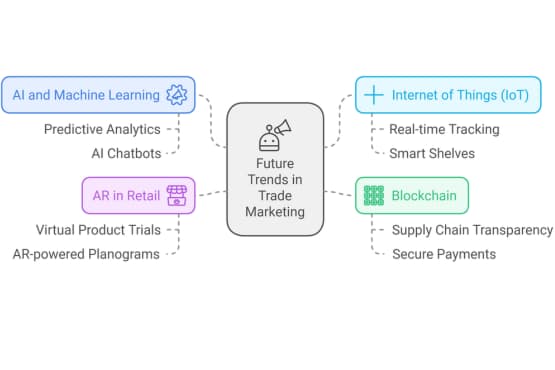Trade marketing is a crucial bridge between manufacturers and retailers, complementing consumer marketing by targeting distributors and wholesalers. This vital role ensures that products reach the right channels, boosting brand visibility and sales. As businesses embrace data-driven strategies, trade marketing now enhances every aspect of the marketing mix—product, price, place, and promotion—while aligning with customer-centric approaches.
Key Takeaways
- Trade marketing directly impacts all aspects of the marketing mix: product, price, place, and promotion.
- Integrating trade marketing with broader strategies boosts brand visibility and sales velocity.
- Data-driven approaches and emerging technologies are reshaping trade marketing practices.
- Balancing traditional and digital strategies is crucial for comprehensive trade marketing success.
- Measuring trade marketing success requires a focus on specific, relevant KPIs
Understanding Trade Marketing in the Marketing Mix
Trade marketing focuses on optimizing the manufacturer-retailer relationship to drive demand and improve market access.

Unlike consumer-focused marketing, trade marketing aims to influence the behavior of wholesalers, distributors, and retailers.
How Trade Marketing Shapes the 4Ps and 4Cs

- Product (Customer Solution): Trade marketing informs product development and packaging based on retailer insights and shelf-space optimization.
- Price (Customer Cost): It influences pricing strategies through trade promotions, discounts, and retailer incentives.
- Place (Convenience): Trade marketing optimizes product distribution and in-store placement for maximum visibility and accessibility.
- Promotion (Communication) drives in-store promotions, cooperative advertising, and retailer-specific marketing campaigns.
Integrating Trade Marketing with the Marketing Mix
Let’s explore how companies have successfully integrated trade marketing into their overall marketing strategies:
Product: Grohe’s Immersive Showroom Experience
Grohe, a leader in bathroom and kitchen fittings, revolutionized their product presentation through trade marketing:

- Implemented AR/VR showrooms, allowing customers to visualize products in their homes
- Collaborated with retailers to create immersive in-store experiences
- Result: 15% increase in conversion rates and 20% boost in average order value
Key Takeaway: Use retailer feedback and emerging technologies to enhance product presentation and customer experience.
Price: Kalyan Jewellers’ Dynamic Pricing Strategy
In today’s fluctuating economic landscape, Kalyan Jewellers implemented innovative pricing strategies:

- Deployed a data-driven retail marketing platform
- Offered personalized discounts based on customer segments and retailer performance
- Result: 25% increase in sales revenue and 30% improvement in customer retention
Industry Trend: A recent McKinsey report shows that 76% of trade marketers use AI-powered dynamic pricing models to respond to market volatility and raw material cost fluctuations.
Key Takeaway: Use data analytics to create agile pricing models that benefit retailers and end consumers while adapting to market conditions.
Place: ExxonMobil’s Integrated Retail Approach
ExxonMobil transformed its distribution strategy through innovative trade marketing:

- Integrated advanced technologies at fuel stations
- Introduced a mobile app for seamless payments and loyalty program management
- Result: 18% increase in fuel sales and 22% improvement in customer satisfaction
Key Takeaway: Leverage technology to create a seamless omnichannel experience that enhances product accessibility and customer engagement.
Promotion: L’Oréal’s Post-Pandemic Marketing 3.0 Strategy
L’Oréal’s Marketing 3.0 approach showcases the power of integrated trade and consumer marketing in the post-pandemic era:

- Aligned digital trade marketing tactics with in-store promotions
- Offered exclusive in-store discounts promoted through digital channels
- Introduced virtual try-on experiences to bridge online and offline shopping
- Result: 35% increase in foot traffic and 28% growth in brand loyalty metrics
Expert Insight: Sarah Johnson, Chief Trade Marketing Officer at L’Oréal, notes: “Post-pandemic, we’ve seen a 40% increase in ‘research online, purchase offline’ behaviors. Our trade marketing now focuses on creating a seamless journey between digital discovery and in-store experiences.”
Key Takeaway: Create synergy between digital and in-store promotions to drive traffic and enhance brand loyalty while addressing evolving consumer shopping patterns.
Customer-Centric Approach: Apple’s Retailer Training Program
Apple exemplifies how trade marketing can enhance the overall customer experience:
- Implemented comprehensive training programs for retail staff
- Ensured consistent brand messaging across all touchpoints
- Result: 90% customer satisfaction rate in Apple Stores and authorized retailers
Expert Insight: Tom Cook, Retail Strategy Consultant, notes: “Apple’s trade marketing strategy focuses on creating a unified brand experience. By aligning retailer training with their consumer marketing, they ensure the customer journey is seamless, whether online or in-store.”
Key Takeaway: Align trade marketing efforts with overall brand messaging to create a consistent and compelling customer experience across all channels.
Challenges and Innovations in Trade Marketing
As the retail landscape evolves, trade marketers face new challenges and opportunities:

E-commerce Integration and Omnichannel Strategies
Mahindra Tractors adapted to the rise of e-commerce with innovative strategies:
- Personalized online product recommendations and financing options
- Implemented a ‘click-and-collect’ model for online purchases with in-store pickup
- Developed a mobile app for real-time inventory checks and dealer appointments
- Result: 40% increase in online leads, 30% boost in digital sales, and 25% improvement in customer satisfaction scores
Key Takeaway: Develop e-commerce-specific trade strategies that complement and enhance in-store efforts, creating a unified brand experience across all channels.
Tech Industry: Samsung’s Virtual Product Launches
Samsung adapted its trade marketing strategy in response to the pandemic:
- Created virtual product launch events for retailers and distributors
- Developed an AR-powered app for retailers to showcase products remotely
- Result: 50% increase in retailer engagement and 25% boost in pre-orders
Key Takeaway: Leverage technology to overcome physical limitations and create innovative ways to engage with retail partners.
Data-Driven Decision Making and AI Integration
Bridgestone showcases the power of data and AI in trade marketing:
- Implemented interactive in-store displays and a data-driven loyalty program
- Utilized AI for predictive analytics in inventory management and personalized promotions
- Result: 20% increase in customer retention and 15% growth in average purchase value
Industry Trend: A recent Gartner study found that 62% of trade marketers plan to increase their investment in AI and machine learning tools over the next two years.
Expert Insight: Dr. Emily Chen, AI Research Lead at Tech Retail Solutions, states: “AI is revolutionizing trade marketing. Our clients in the FMCG sector are seeing a 30% increase in promotional effectiveness by using AI to optimize timing, pricing, and retailer-specific offers.”
Key Takeaway: Invest in advanced analytics and AI tools to gain actionable insights, optimize trade marketing ROI, and create more targeted, effective campaigns.
Trade Marketing Future & Trends

- AI and Machine Learning:
- Predictive analytics for inventory management and personalized promotions
- AI-powered chatbots for enhanced retailer support and instant query resolution
- Internet of Things (IoT):
- Real-time tracking of product performance and consumer behavior in-store
- Smart shelves that provide instant inventory updates and consumer interaction data
- Blockchain:
- Enhanced transparency in supply chain management
- Streamlined and secured trade promotion payments and reconciliation
- Augmented Reality (AR) in Retail:
- Virtual product trials and interactive in-store experiences
- AR-powered planograms for optimal product placement
Measuring Trade Marketing Success: Key KPIs
To gauge the effectiveness of trade marketing efforts, focus on these KPIs:

- Sales Lift During Promotions: Measure the percentage increase in sales during specific trade marketing campaigns.
- Return on Trade Spend (ROTS): Calculate the revenue generated for every dollar spent on trade marketing.
- Market Share Growth: Track changes in market share attributable to trade marketing initiatives.
- Distribution Gains: Monitor increases in product distribution across retailers.
- In-Store Visibility Metrics: Measure factors like share of shelf space and promotional display effectiveness.
- Digital Engagement: Track online interactions, click-through, and conversion rates for digital trade marketing efforts.
Actionable Steps for Effective Trade Marketing
To maximize trade marketing’s impact within your overall strategy:

- Align trade marketing objectives with overall brand and consumer marketing goals
- Invest in data analytics and AI tools for informed decision-making
- Develop an omnichannel strategy that integrates e-commerce and physical retail
- Collaborate closely with retailers to create mutually beneficial promotions
- Balance traditional in-store tactics with innovative digital approaches
- Continuously measure trade marketing initiatives using relevant KPIs
- Stay informed about emerging technologies and be prepared to adapt quickly
For Startups and Small Businesses:
- Focus on building strong relationships with a few key retailers
- Leverage cost-effective digital tools for promotion and analytics
- Create targeted, high-impact promotions that align with your brand message
Established Companies in Saturated Markets:
- Innovate with emerging technologies like AR and AI to stand out
- Develop sophisticated, data-driven strategies for personalization
- Invest in comprehensive retailer training programs to enhance the brand experience
For Companies Entering Developing Markets:
- Conduct thorough market research to understand local retail landscapes
- Adapt strategies to local consumer behaviors practices
- Focus on building brand awareness through strategic partnerships with local retailers
FAQs:
How does trade marketing differ from consumer marketing?
Trade marketing focuses on the B2B relationship between manufacturers and retailers, while consumer marketing targets end-users directly.
Can trade marketing strategies conflict with overall brand marketing?
While conflicts can arise, aligning trade marketing with brand objectives ensures that both complement each other, ultimately driving greater value.
How is digital transformation affecting trade marketing?
Digital transformation enables more targeted, data-driven trade strategies and creates new opportunities for omnichannel integration.
What are common challenges in implementing effective trade strategies?
Challenges include aligning with multiple retailer strategies, measuring ROI accurately, and maintaining brand consistency across various channels.
How can small businesses effectively utilize trade marketing with limited resources?
Small businesses can focus on building strong relationships with a few key retailers, leveraging digital tools for efficiency, and creating targeted, high-impact promotions.
What’s the difference between trade marketing and shopper marketing?
While trade marketing focuses on the manufacturer-retailer relationship, shopper marketing targets the end consumer’s in-store (or online) behavior. However, these strategies often work in tandem.




